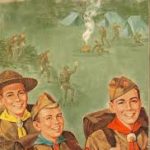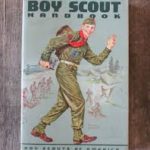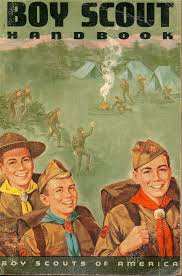 I was always a reluctant boy scout. Raised Mormon, it was expected of me that I become a scout. Perhaps it was because I grew up mostly with sisters (eventually 10 would fill my parents’ house), or perhaps it was because I was shy when it came to team sports, and cutthroat basketball in the church’s “cultural hall” after our weekly scout meetings was de rigeur for Utah scout nights. The flying elbows and hot tempers were the Lord of the Flies shadow side to the Scout Oath and the Scout Law, the merit badge work and the knot-tying.
I was always a reluctant boy scout. Raised Mormon, it was expected of me that I become a scout. Perhaps it was because I grew up mostly with sisters (eventually 10 would fill my parents’ house), or perhaps it was because I was shy when it came to team sports, and cutthroat basketball in the church’s “cultural hall” after our weekly scout meetings was de rigeur for Utah scout nights. The flying elbows and hot tempers were the Lord of the Flies shadow side to the Scout Oath and the Scout Law, the merit badge work and the knot-tying.
The LDS (Mormon) Church was an early adopter to the Boy Scouts of America (BSA), modeled in 1910 after a similar program for boys in Britain. In fact, the Church became BSA’s first charter member, the program instantly installed as the activity component of its youth organization and then its official activity program for young men ages 12-16 in 1928.
In the late 60s and 70s scouting and my advancement through the Mormon priesthood were indistinguishable. Until 1978 those of African descent were not allowed to be priesthood holders which, in the Church, began at age 12 with the office of deacon, and it was a shock when the mechanism for moving black boys through scouting was non-existent when they moved from cub scouts to boy scouts but the initiation was suddenly an ecclesiastical one, and therefore unavailable to them.
In May 2018 the Church announced that it was no longer to be a charter member of BSA. Instead it will roll out beginning next year (2019) its own new initiative for Mormon youth worldwide “to teach and provide leadership and development opportunities to all children and youth, to support families, and to strengthen youth everywhere as they develop faith in our Lord and Savior, Jesus Christ.” The press release further indicated that “[t]his new approach is intended to help all girls and boys, young women and young men discover their eternal identity, build character and resilience, develop life skills, and fulfill their divine roles as daughters and sons of God.”
In contrast to this new initiative, the purpose, aim and mission of BSA suddenly seems spectacularly secular. While faith, as far as I know, has always been a component of scouting, one that was more important in some troops and councils than others, the Mormon replacement of scouting is now about eternal identity (read: spiritual; read: institutional Mormonism). No longer is Mormon scouting or whatever its new name will be “to serve others by helping to instill values in young people and, in other ways, to prepare them to make ethical choices during their lifetime in achieving their full potential”.” Instead, it’s now about being a better Mormon.
 What you may not be able to discern from the Church’s official statement about the reasons for leaving the BSA is that the Church of Jesus Christ of Latter-day Saints continues to brook little if any accommodation for homosexuals, in particular scout leaders who are gay and who, after a protracted and tortured reckoning over the past several years with the organization were finally allowed in. So, sadly, the departure of the LDS Church from the BSA is partly if not largely about that.
What you may not be able to discern from the Church’s official statement about the reasons for leaving the BSA is that the Church of Jesus Christ of Latter-day Saints continues to brook little if any accommodation for homosexuals, in particular scout leaders who are gay and who, after a protracted and tortured reckoning over the past several years with the organization were finally allowed in. So, sadly, the departure of the LDS Church from the BSA is partly if not largely about that.
But it is not only a departure of affiliation for the Mormon Church due to its homophobia; it is a stark departure of the institutional church from the world, as scouting engaged it, and marks an even deeper dive than before into its own totalizing universe. As with evangelical Christianity, bent on promoting not only its creed and moralisms but its own culture through a highly monetized Christian literature, music, clothing, and educational systems (including home schooling), so Mormons are retreating from the world at large into their own reality underscored as it is by a unique cosmology, culture and practice; a scorching political conservatism; and a seemingly intractable siege mentality
I lost interest in advancing through scouts by the time I hit high school. There I was more interested in competitive swimming and water polo, drama, and academics than getting those last two merit badges which would have made me a “Life” scout, one stop away from being an “Eagle,” the culminating designation. Nor was I as interested in the traditional scouting skills of making a fire from flint and steel, building a military-styled rope apparatus to test one’s physical agility and first aid. For on thing, being from the Mountain West, a new style of outdoor recreation–traditionally a “manly” thing–was emerging, one of downhill skiing at world-class resorts, mountain biking, hang gliding, water skiing and rock climbing. I preferred them.
Later in life, while raising my own boy, albeit outside the Mormon fold, I saw scouting as a critical way to socialize him and to help build his confidence both physically and mentally. I also saw it as a great way to meet friends. I actually believed then, and still do, that boys need to be with boys sometimes, even often. That they need to figure out together something about gender and community; fairness and compassion; and the sheer joy of being alive in their bodies as they grow into men. That Josiah never cottoned to the Boy Scouts didn’t surprise me, as, in Salt Lake City where we were living, it was welded to the LDS ward house. Scout leaders were priesthood leaders. It was saturated in religion. Prayers were said ad nauseam and there were relentless references to that other side of the youth program for boys: the Mormon priesthood and everything that stemmed from it. By default it was a system of indoctrination with which I was more than familiar.
But growing up, the Boy Scouts was something else to me.
Today, I remember fondly that as a young Mormon Boy Scout, the BSA was a kind of lifeline to something beyond my insulated world that had all the trappings of the real thing. During the 60s and 70s the Mormon Church was going through a sea change. It was correlating all of its programs–its literature, its Sunday School lessons, its Priesthood/Scouting programming, its missionary program, its “family night” mandate, seminaries, temple worship and virtually everything else into rigid, simplistic and unforgiving fundamentalism. It was quickly becoming an industry that was “charmless and absolute,” to quote a critique of Steven Covey’s best selling self-help book Seven Habit of Highly Effective People. (That it was doubly a critique of Newt Gingrich and his “Contract with America” back in the 90s may provide even more resonance with the reader.)
“Correlation” was the beginning of Mormons’ creating their own totalizing culture in which, especially in the Mormon Corridor–a geographic stretch from Southern Alberta Canada, through Idaho, Utah and Nevada and down to the Mexican border–you never had to leave the Mormon bubble to experience as though you were living life. That you were Anglo white also allowed you to “pass” in the business and sports world. So that was pretty cool too. By the time I graduated from Brigham Young University with a BA, Mormon life was a glue ball of undifferentiated components that had no clear boundaries. I didn’t know where I ended and my family began. And my family of birth didn’t know where it ended and the institutional Church began. Finally, living in The Corridor, it was impossible to tell where the institutional Church ended and the non-Mormon world began. Was there a sustainable world outside “the Gospel”? A world worth integrating and honoring?
Scouts was a welcome departure from the cloying fusion of the Latter-day Saint individual with family and institutional church. Scouts had its own handbook, for one thing. It’s own liturgy in the Scout Oath and Scout Law. It had its own rituals, including hand shakes and signs (which for a Mormon is telling). In short, scouts was a portal into the real world, the secular world, the America that Mormons claimed to honor and regularly appealed to, but was determined to remain a part from.
Where did I learn about maturation? It wasn’t at Wasatch Elementary in Provo where the Mormon engine kicked in during sixth grade and the school brought in LaVell Edwards, head coach of BYU football, to talk vaguely about mental, physical and spiritual components of maturation. (A strapping, deep-voiced man, indeed, but he didn’t even use the word “sex” once.) The Boy Scout Handbook actually said the word “penis” (horrors!), that “your penis will increase in size” (I memorized the phrase) and sport hair. It said that masturbation was something you would want to talk to your elders about. It talked about hormones and inferred that the heat of manhood would both liberate and constrain me and that what I had learned by repeating the universally embraced scout oath and scout law would be a guide to my growing up. That there was a whole man to come into form, and that that whole man was designed to enter the world, the real world of adulthood, as an asset to the broader world, an accomplishment . . . a joy.
I turned to my scouting handbook when religious indoctrination became too much to bear. I wore my uniform with pride partly, I realize now, because it wasn’t the garb of the faith; it made me part of a global brotherhood, or at least an American brotherhood of guys who found themselves slugging the shit out of each other at Camp Steiner when Scoutmaster John Cannon wasn’t looking. It helped us figure out that if the guy doing KP didn’t clean up well we all got diarrhea; how to bandage another boy’s hand and the tenderness it evoked between males; how the boy Eugene was different than others, in retrospect “gay,” but that he was one of us, that he could kill it on the piano and the ward organ during sacrament meeting and when pushed could beat you playing one-on-one b-ball because he was so damn tall.
Scouts taught you how to turn the other way when enduring the mandatory swim in Steiner Lake which collectively re-ascended our testicles in the frigid water, so as not to shame another boy during his display of abject fear and the “sissiness” that we were all experiencing together. It taught us how to admire the musculature of another, the early hair on someone’s chest in a social and sometimes competitive setting. It placed nature in all its beauty and terror in front of our nose and told us to enter it, to swim through it, to climb it, to rest in its embrace, to build something both external and internal. It taught us how to be a friend, including to Eugene who despite everything, and the early onset of vaulting fear that inundated the country during the 80s, would die of AIDS before he was age 30. That Gene was suddenly dead at 27 raised a question for me and others, I presume, about the body and mind and spirit of man no more. And though the Gospel with a capital Mormon “G” narrative was there, flooding the plains as usual, the memory of Gene, my friend, as a man comes in part from our time together in scouting where the journey of life was raw, but acknowledged, the farts and fears of growing up were both jeered at and dealt with. I will always remember how Gene and I shared the sidelong glances at each other during church hokum. The glances were made available to us because of the wiggle room provided by mutual cracks in our universe like scouts.
Scouts was a portal into the real world that our ever-closing, religion-soaked and inhibited community of faith seemed bent on keeping us at bay. And I am sorry, as I think back on my time as a scout–as discomfiting as it was–that my Mormon nephews and grand-nephews will be locked-in even further into an alternate universe of religious fundamentalism that only seems to intersect the world tangentially, suspiciously, and, in my view, superficially. A fundamentalism that teaches its members not only to find their own life experience suspect, but disallows its members to even register their personal experience. Scouts was the antidote to that: it said to us, “Wake up!” “Grow Up!” “Be the man only you were destined to be!” “Damn the Mormon torpedos, full steam ahead!.”
Once I left the fold, stepped over the line, remarked to myself as much as to anyone that I was no longer a believer, I went in to free fall. I lost my community, my family of birth and the moral compass that had been fused to the religion of my childhood which I had jettisoned. I grappled for a handhold. I’m still grappling. And I am grateful for the men and the boys who under the wheeling stars over Camp Steiner lay in the grass with me as were told a story in the dark of the mighty Uinta Mountains about an Indian and a White man who had been tracking each other for a kill through the trees and had both been dropped at the same time by the same tree split by a bolt of a lightning. As they lay there next to each other dying they began talking. And they learned that they were more similar than different. That they suffered from the same fears and that they brandished the same hopes.
Now that the church of my childhood has abandoned the Boy Scouts of America, there will be one less crack in the Mormon universe for Latter Day Saint boys as well as those who lead them. The blind leading the blind. What the LDS leadership can’t seem to learn is that the world doesn’t just need need Mormon boys; Mormon boys need the world.
#
Postscript: I’m not sure how I feel about the Boy Scouts of America changing its name and its programming to include girls. I suspect it is inevitable considering how gender identification reveals itself in our contemporary age and as we acknowledge the relentless sexism that underwrites our country. (The Girl Scouts have something to say about it as well.) But I think my thesis still holds water that Mormon youth with be closed off from one more needed reality check as the LDS Church parts ways with the BSA.
Timeline:
1907
Scouting movement is founded in England by British General Robert Baden-Powell.
1910
The Boy Scouts of America is incorporated as an organization; later that year, the first Scout unit in Utah is formed.
1913
The Church officially joins the Boy Scouts of America as its first charter organization, adopting the program as the activity arm of its Mutual Improvement Association.
1928
The Church designates Scouting as the official activity program for young men ages 12–16.
1952
The Church announces Primary will sponsor Cub Scouting, with 11-year-old Scouts a part of a Guide Patrol under the Primary’s direction.
1954
The Duty to God Award is created for boys ages 12–18.
1970
The Venturing program is created for young men ages 14–15, while those 16–18 are Explorers.
1978
LDS leaders in Utah develop the Varsity program to eventually replace the Church’s Venturing program in 1983 and become a BSA program in 1984.
2017
The Church drops Scouting’s Varsity and Venturing programs from its Young Men program for boys ages 14 through 17, effective January 1, 2018.
2018
The Church announces it will no longer be a charter member of the Boy Scouts of America. In place of it will be a church-designed/church-run program for youth.

